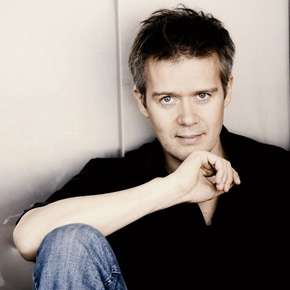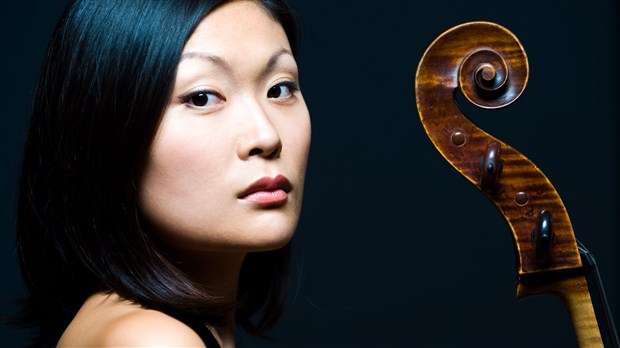|
Back
The Blurry World of Mr. Aa New York
Manhattan Center Great Ballroom
10/28/2013 -
Michael Van Der Aa: Memo – Oog – Transit – Up-Close
David Bowlin (Violin), Kaori Yamagami, Michael Nicolas (Cellos), Jacob Greenberg (Piano), Musicians from Orpheus Chamber Orchestra
International Contemporary Ensemble, John Schaefer (post-concert moderator)

M. van der Aa (© Marco Borggreve)
Hopefully, a precise meaning for the phrase “White Light Festival” will never be defined. And in that light, the annual Lincoln Center event had exactly the right concert last night. Michael van der Aa should (and will) always remain a five-dimensional Rubik’s Cube of indefinable blurs. Then again, if his combination of film, aleatory music, electronics and instrumentation could ever be put into words...well, then, Michael van der Aa probably wouldn’t have written it.
Think of it this way. The background of this 43-year-old Dutch composer, a luminary in Europe if not New York, is terrifically eclectic. A one-time rock musician, film-maker (he studied at NYU), electronic engineer, inventor, a philosopher searching for illusion and reality and (whew!) a composer, Mr. van der Aa is not your smiling easily accessible artist.
On the other hand, one doesn’t have to be educated in musical structures to be curious by his work. In fact, the packed-out audience last night was rapt with attention. Not a single cough, not one page turned in a program (it was too dark for that anyhow), not one raised eyebrow for his work. If we couldn’t exactly get to the heart of it–even the astute John Schaefer didn’t quite crack the secret in his post-concert conversation with the composer–we certainly were never benumbed by the sounds and pictures.
Quite the opposite. Once the films were shown, the music became either secondary, or...well, film music.
The four works become more complex as the evening went on. First was Memo, played with virtuosity by David Bowlin, a founding member of the International Contemporary Ensemble, and a man who took both his instrument, and the tiny little tape-recorder quite seriously. That is, Mr. Bowlin played a beautifully improvised section, a cadenza, then back again seemingly without any trouble–along with his partner the 1950’s style tape recorder.
Thus the name Memo, and thus the violin’s realistic sounds of a rewinding tape, and thus the tape sounds themselves recording and emulating the violin, the violin itself doing variations to the antiquated instrument. It was (oh, I hate this word) interesting. It was not exactly embracing.
More sounds were on their way, these far more complex. Oog is Dutch for “eye”, and here Mr. Aa used cello and pre-recorded tape to show (say the extensive enlightening program notes by composer Patrick Catillo) how “an eye receives light, transmitting the image to the brain. Oog refracts the cello’s signature timbre into a sonic tapestry.”
Well, maybe. At least Oog was not as serious as Memo. It was a jaunty romp filled with slaps and snaps on Michael Nicolas’ cello, with an electronic tape that played cello music of a sort, but ended up with a series of rocks perhaps hit together. Many many times. It was perhaps not meant to be fun but certainly not terribly serious either.
I have gone through these opening two works quickly, because they seemed like experiments from a very accomplished experimenter, but their communication was more in the program notes than the execution.
The final two works showed Michel van der Aa as film director. The first, Transit was an amalgamation of previous works he wrote. Far more fascinating was a black-and-white film with an antediluvian man–he resembled the old Pablo Picasso–attempting to do things.
The things he did would be simple to us, but became the legendary Labors of Heracles for him. The terrible difficulties of trying to open a door or make a cup of tea, or pour the tea, or bottling its steam or attempting to walk through his house becomes as wearying to us as to him.
Is he crazy? Why does he live along with only a picture of himself in a frame? How does he manage to survive if everything is so difficult.
Pianist Jacob Greenberg didn’t help matters too much with his repeated motifs, his sometimes Mickey Mouse accompaniment to the travails. But when a movie is on screen, I have a difficult time listening to music and watching at the same time. I wanted to see our Picasso clone try to survive in his non-survivable world.
Mr. van der Aa’s most recent work or the evening, Up-Close, was his longest (a full 32 minutes), his most complex in resources (a whole string orchestra, a solo cellist, a film), and a truly inter-active work.

K. Yamagami (© Lutz Sternstein)
Canadian cellist Kaori Yamagami not only had to play the complex solo part, accompanied by that string orchestra, but she had to do a bit of acting–and lifting.
The old woman of the film (the composer is obsessed with age) is first seen on screen with a kind of replica of the orchestra (empty seats) and screen itself. She is writing a kind of code, taking it quite seriously. Her next scene is taken almost literally from The Blair Witch movie, the trees in a forest covered with papers, which she puts into a machine (a Rube Goldberg contraption, actually invented by Mr. van der Aa).
Now starts the interaction. She carries a standing light across the screen–and lo and behold, Ms. Yamagami has put down the cello and carries the same style lamp across our real stage. The old woman sits and plays with something and our cellist sits and plays with the cello.
And then goes back to the orchestra to finish things up.
Forty years ago, this would have been called a “happening”. And not a very inventive happening either! But Mr. van der Aa obviously is looking for far more. Reality, illusion, screen, life, music, experimenting etc etc etc.
I guess a more profound writer than myself could draw various theses, documents and even books about his subjects. For myself, I was happy to see the 70-minute show, with thanks that such inventive minds exist. These were not the Labors of Heracles at all. But like the fluttering notes on violin, cellos and piano, they will not remain long in my conscious or unconscious brain.
Harry Rolnick
|